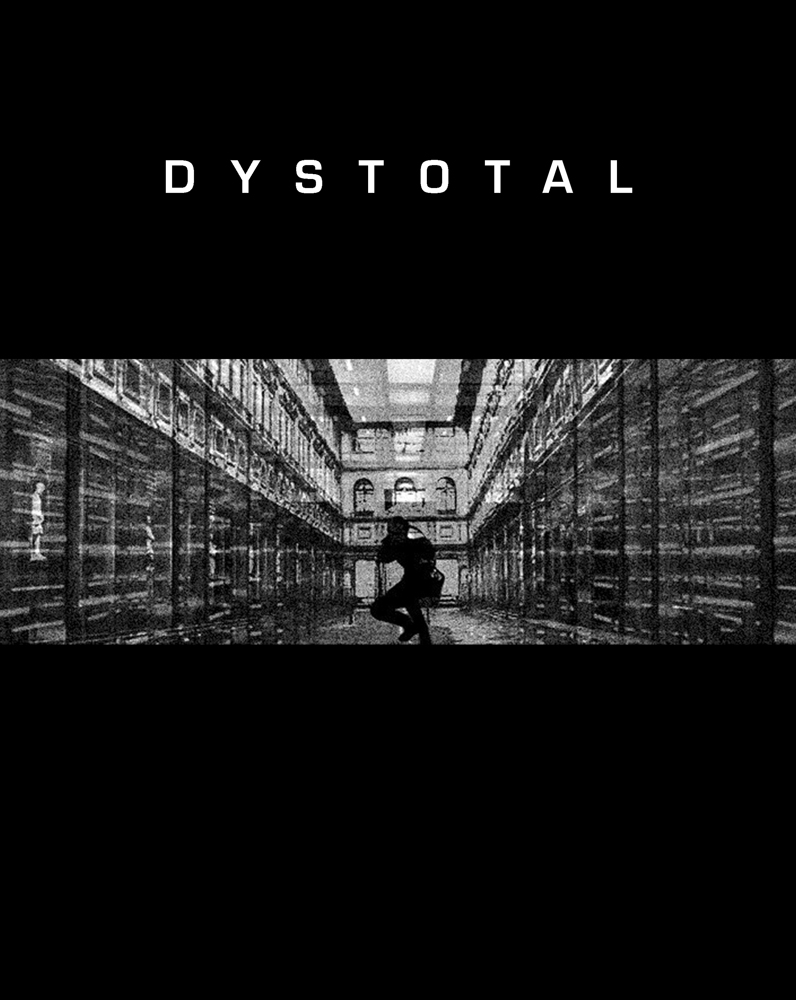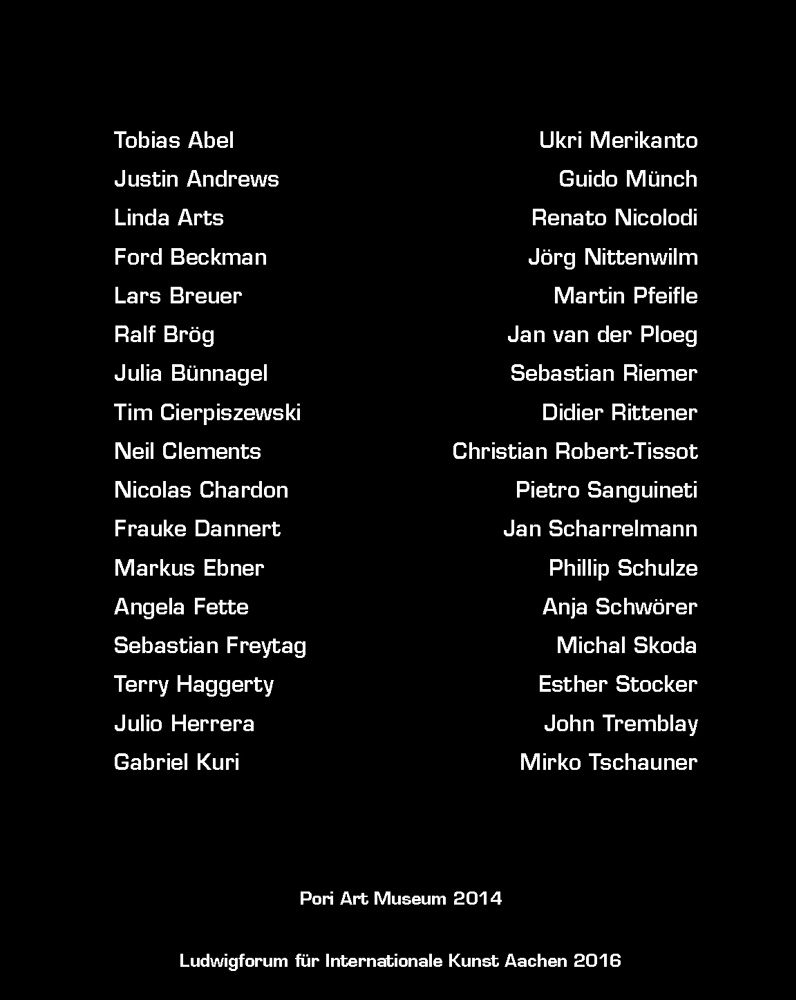DYSTOTAL, 2016
Ludwig Forum Aachen and Pori Art Museum
Texts by Daniel Cohnitz, Stephan Günzel, Pia Hovi-Assad, Tara MacDonald, Jari Ortwig, Ursula Ströbele, Konsortium
19,5 x 24,5 cm
342 pages
Koenig Books, London
-
Prolog KONSORTIUM dt.
INTRO: SMASH CUT TO: CLOSE UP EYES
„Blue eyes snap open. Woken from a bad dream. WIDEN to reveal a woman’s face to go with the eyes. It’s not perfection, but it’s close. We’ll call her ALICE.“
Alice erwacht orientierungslos; suchend durch die Räume des Settings, durchschreitet die Kolonnaden von Schloss Lindstedt, dreizehn Säulenpaare, Nacht, Laub – ein Baukörper von Ludwig Persius, arkadische Vision: Tempel, Monopteros, Freitreppe und der Kolonnadengang.
CUT: CHANGE IN BLACK AND WHITE
Rückblende: Schloss Lindstedt, der Garten Lennés, Ludwig Persius, Schinkel.
TEXT AUS DEM OFF
„Der Spätklassizismus des neunzehnten Jahrhunderts spiegelt die in vielen Schichten vorherrschende Sehnsucht nach der italienischen Klassik wider. Bemerkenswert ist dabei die Detailtreue, mit der historische Vorbilder auch von den Schülern Karl Friedrich Schinkels, entscheidender Kopf des preußischen Klassizismus, Ludwig Persius, August Stüler oder Ferdinand von Arnim umgesetzt wurden. Einzelne Versatzstücke werden dazu – allerdings oft, ohne einem übergeordneten Ganzen zu dienen – kombiniert. Unter der Beteiligung der genannten Schüler entstand mit großer Verzögerung bis 1861 Schloss Lindstedt. Hier verbindet ein aufgesockelter Kolonnadengang, der streng den Regeln der korinthischen Ordnung folgt, den eigentlichen Baukörper mit der Lindstedter Chaussee. Auch diese final realisierte Minimallösung eines Schlosses bleibt dabei Kulisse.“
DISSOLVE TO COLOR
Durch die Kolonnaden von Schloss Lindstedt weht Laub. Stille. Dunkle Nacht. Der Abstieg zum Hive, dem Reich der Umbrella Corporation, der Welt der Untoten. Firmenimperium. Erkennen des Untergangs, der Gang, die Spiegel, hinter den Spiegeln, die Machbarkeit der Welt: Tyrell, Umbrella, Skynet, Lunar Industries – der moderne Prometheus. CUT: Villa Diodati, Cologny am Genfersee
Stofftapeten, zum Teil verschlissen, farblich abgestimmtes Mobiliar, rötliches Holz. Regen. Es ist dunkel, ein großer Tischleuchter mit zahlreichen Kerzen steht improvisiert auf dem Tisch. Rotes Wachs tropft, in einem Kamin lodert Feuer. Vier Personen sitzen um einen Tisch. Drei Männer hören zusammengesunken und gebannt auf die Stimme einer Frau. Konzentriert hält sie einen Stapel mit Manuskriptseiten in den Händen. Trotz des Feuers sind die Personen in Mäntel und Decken gehüllt.
Percy Bysshe Shelley reibt seine Hände – es ist das Jahr ohne Sommer.
Das Knacken des Feuers. Die Stimme der Frau wird langsam eingefadet. Zunächst sind ihre Worte nur zu ahnen, dann fest und deutlich:
MARY GODWIN
„... ‚Aber bald‘, rief er mit feierlichem, ernsten Tone, ‚werde ich tot sein und das, was ich empfand, nicht mehr länger empfinden müssen. Und dann ist es vorbei mit diesen entsetzlichen Qualen. Jubelnd werde ich meinen Scheiterhaufen besteigen und mich freuen an den lodernden Flammen, die mich umzüngeln. Und die Flamme wird in sich zusammenbrechen und der brausende, frische Wind wird meine Asche weithin über das endlose Meer tragen. Ich werde Frieden finden; und wenn mein Geist noch weiter lebt und denkt, dann werden es andere Gedanken sein als die, die mir das Erdenleben verbittert haben. Lebt wohl!‘
Rasch sprang er aus dem Fenster der Kajüte in den Kahn, der längsseits am Schiffe befestigt war. Die Wogen trugen ihn davon, immer weiter und weiter, bis er in der Dämmerung verschwand.“
Pause. Stille. Knacken. Leder.
Langsam:
MARY GODWIN
„Frankenstein oder Der Moderne Prometheus. So soll sie heißen, und unter diesem Titel werde ich meine Geschichte veröffentlichen.“
JOHN WILLIAM POLIDORI
„Wenn meine Gedanken von Interesse sind, so möchte ich Mary Godwin gerne folgen. Allerdings berichte ich diesmal als Arzt nicht über Sinnestäuschungen und Albdrücke. Ich werde darlegen, wie das Blut der Lebenden auch die Toten nährt. Diese Eigenschaften finden sich im Untoten, im Wiedergänger und im Vampyr.“
CUT: ein leerer Platz, ein langer Arkadengang, ein harter Schatten, in der Mitte des Platzes eine Liegende auf einem Sockel, im Hintergrund ein Zug. Absolute Stille. Stillstand. De Chirico. Die Idee der Goldenen Zeit der Kunst, ein aufblitzendes Fragment, gefroren im Klischee, in der Reproduktion.
ÜBERBLENDUNG: Mitten in New Orleans, tausende Kilometer bis Rom. Piazza d'Italia. Die Übersetzung der Antike vollendet sich als postmoderne Platzgestaltung.
In „Hard Target“, dem ersten Hollywoodfilm von John Woo, wird Charles Willard Moores Vorstellung der fragmentierten, klischeehaften Kulisse zum Bühnenbild einer Obdachlosensiedlung. Urin und Heimatlosigkeit. Das Filmset geht auf Distanz zum Projekt „Postmoderne“, die sich ruinenhaft gestaltete und nun ihre Bedeutungsmacht verloren hat. Sie gliedert sich nahtlos in die gescheiterten urbanen Anstrengungen der Moderne ein. Die Zeitgenossenschaft triumphiert über die Kunstform. Das Kunstpanorama de Chiricos faltet sich geschichtlich weiter auf und wird Bestandteil ...
Allen Kunstformen liegt dieser Wahnsinn inne: Aufschwung, der Glanz des Neuen, das Symbolhafte, das Bedeutungsvolle und im Schatten das Ruinenhafte, Entstellte und Entfremdete. Eine Form von limitierter open source operation, die permanente Neuschreibung, Umschreibung: der Klassizismus/die Wiederholung.
EINE STIMME
„Eine negative Übersetzung der Moderne. Ein Gegenbild, eine Wiederholung. Die formalistische Reduktion als Ausdruck des Negativen, als Wiedergängerphänomen. Die Wiederholung der großen Momente der Abstraktion, in ihrer Gebrochenheit, in ihrer Tragik, ihrer Einsamkeit, ihrer Selbstüberschätzung, ihrem Glanz.“
DYSTOTAL.
SMASH CUT:
The RV cruises down a street lined with abandoned cars and trucks. No drivers, no passengers, no pedestrians. MATT and ALICE are the only one alive here.
A Brink’s armored car lies on its side. A strongbox spills $100 bills out into the street. They flutter idly in the wind. EXT. BROOKLYN BRIDGE – DUSK
The RV races over the deserted bridge, headed for Manhattan.
THE CAMERA CRANES UP to reveal the New York skyline. Both familiar, yet terrifyingly different. For now there is no movement, no lights, no sign of life.
The sun sinks beneath the tall buildings, and the tiny RV is swallowed by the silent city.
THE END
(http://www.dailyscript.com/scripts/resevil.html) -
Prolog KONSORTIUM engl.
INTRO: SMASH CUT TO: CLOSE UP EYES
Blue eyes snap open. Woken from a bad dream. WIDEN to reveal a woman’s face to go with the eyes. It’s not perfection, but it’s close. We’ll call her ALICE.
Alice wakes up disoriented; scouring through the rooms of the setting, strides through the colonnades of Lindstedt Castle, thirteen pairs of columns, it’s night, fallen leaves – a building by Ludwig Persius, Arcadian vision: temple, monopteros, perron, and the colonnaded walkway.
CUT: CHANGE TO BLACK AND WHITE.
Flashback: Lindstedt Castle, Lenné’s garden, Ludwig Persius, Schinkel.
TEXT FROM OFF
“The Late Classicism of the nineteenth century mirrors the yearning for Italian classicism endemic in many groups of society. What is remarkable is the attention to detail with which the historical paragons were replicated, including those built by the disciples of Karl Friedrich Schinkel, the leading mind in Prussian classicism, Ludwig Persius, August Stüler, and Ferdinand von Arnim. For this purpose, individual set pieces are combined, often without serving a greater whole however.
With the involvement of the aforementioned disciples, Lindstedt Castle was created by 1861 after a prolonged delay. Here an elevated colonnade walkway that strictly follows the rules of Corinthian order connects the building to Lindstedt Chaussee. Even the last implemented minimal solution for a castle remains a stage setting.”
DISSOLVE TO COLOR
Leaves rustle through the colonnades of Lindstedt Castle. Stillness. Dark night.
The descent into The Hive, the realm of the Umbrella Corporation, the world of the undead. Business Empire. Recognize the demise, the passageway, the mirrors, behind the mirrors, all that is doable in the world: Tyrell, Umbrella, Skynet, Lunar Industries – the modern Prometheus.
CUT: Villa Diodati, Cologny near Lake Geneva
Wall coverings, some worn and flimsy, furniture all the same color, reddish wood. Rain. It’s gloomy, a need to improvise, a large lamp with scores of candles stands on the table. Red wax drips, flames crackle away in the fireplace. Four people sit around a table. Three men listen, sunken and spellbound, to the voice of a woman. Concentrated, she holds a stack of manuscript pages in her hands. Although the fire blazes away they are all wrapped up in coats and blankets.
Percy Bysshe Shelley rubs his hands – it is the Year Without a Summer.
The crackle of the fire. The voice of the woman is slowly faded in. At first her words are barely audible, then they become firm and clear:
MARY GODWIN
“… ‘But soon,’ he cried, with sad and solemn enthusiasm, ‘I shall die, and what I now feel be no longer felt. Soon these burning miseries will be extinct. I shall ascend my funeral pile triumphantly, and exult in the agony of the torturing flames. The light of that conflagration will fade away; my ashes will be swept into the sea by the winds. My spirit will sleep in peace; or if it thinks, it will not surely think thus. Farewell.’ He sprung from the cabin-window, as he said this, upon the ice-raft which lay close to the vessel. He was soon borne away by the waves, and lost in darkness and distance.”
A pause. All is still. Crackling. Leather.
Slowly:
MARY GODWIN
“Frankenstein: or, the Modern Prometheus. That’s what it shall be called, and I shall publish my story under this title.”
JOHN WILLIAM POLIDORI
“If my thoughts are of interest, then I would very much like to follow Mary Godwin. This time I report not as a physician of hallucinations and nightmares. I will show how the blood of the living also nourishes the dead. These characteristics are to be found in the undead, in the revenant, and in the vampyre.”
CUT: a deserted square, a long arcade, a hard-edged shadow, in the middle of the square a lying figure on a socle, in the background a train. Absolute stillness. Standstill. De Chirico. The idea of a Golden Age of art, a flashing fragment, frozen in cliché, in the reproduction.
CROSS-FADE: in the middle of New Orleans, thousands of kilometers from Rome. Piazza d’Italia. The translation of Antiquity culminates in postmodern plaza design.
In Hard Target, the first Hollywood film by John Woo, Charles Willard Moore’s idea of a fragmented, clichéd piazza becomes the setting for a homeless settlement. Urine and homelessness. The film set distances itself from the project “postmodern”, which has developed ruinously and has now lost its power of meaning. It seamlessly fits in with the other failed urban projects of Modernity. The contemporary triumphs over the art form. De Chirico’s art panorama continues to unfold historically and becomes a component… This madness inheres to all forms of art: boom, the glamor of the new, the symbolical, laden with importance and in the shadows lay the ruin, the distorted and the alienated. A form of limited open source operation, the permanent rewriting, rephrasing: classicism / repetition.
A VOICE
A negative translation of Modernity. Counter-image, repetition. The formalistic reduction as expression of the negative, as the revenant phenomenon. The repetition of the great moments of abstraction, in their brokenness, in their tragic, their solitude, their self-overestimation, their splendor.
DYSTOTAL.
SMASH CUT:
The RV cruises down a street lined with abandoned cars and trucks. No drivers, no passengers, no pedestrians. MATT and ALICE are the only one alive here.
A Brink’s armored car lies on its side. A strongbox spills $100 bills out into the street. They flutter idly in the wind.
EXT. BROOKLYN BRIDGE – DUSK
The RV races over the deserted bridge, headed for Manhattan.
THE CAMERA CRANES UP to reveal the New York skyline. Both familiar, yet terrifyingly different. For now there is no movement, no lights, no sign of life.
The sun sinks beneath the tall buildings, and the tiny RV is swallowed by the silent city.
THE END
(http://www.dailyscript.com/scripts/resevil.html)



